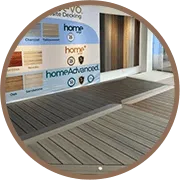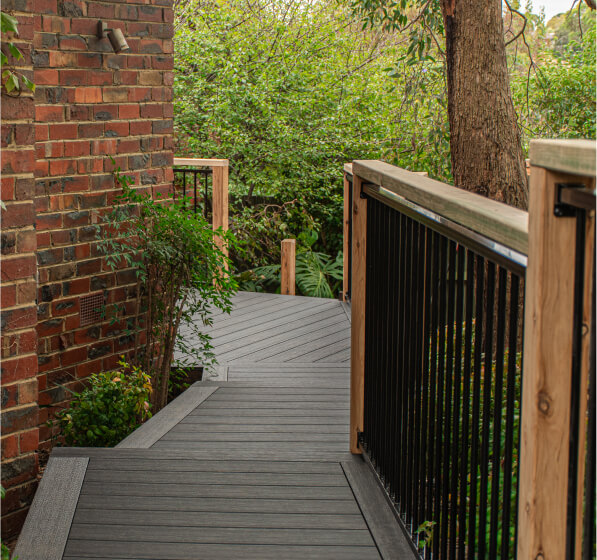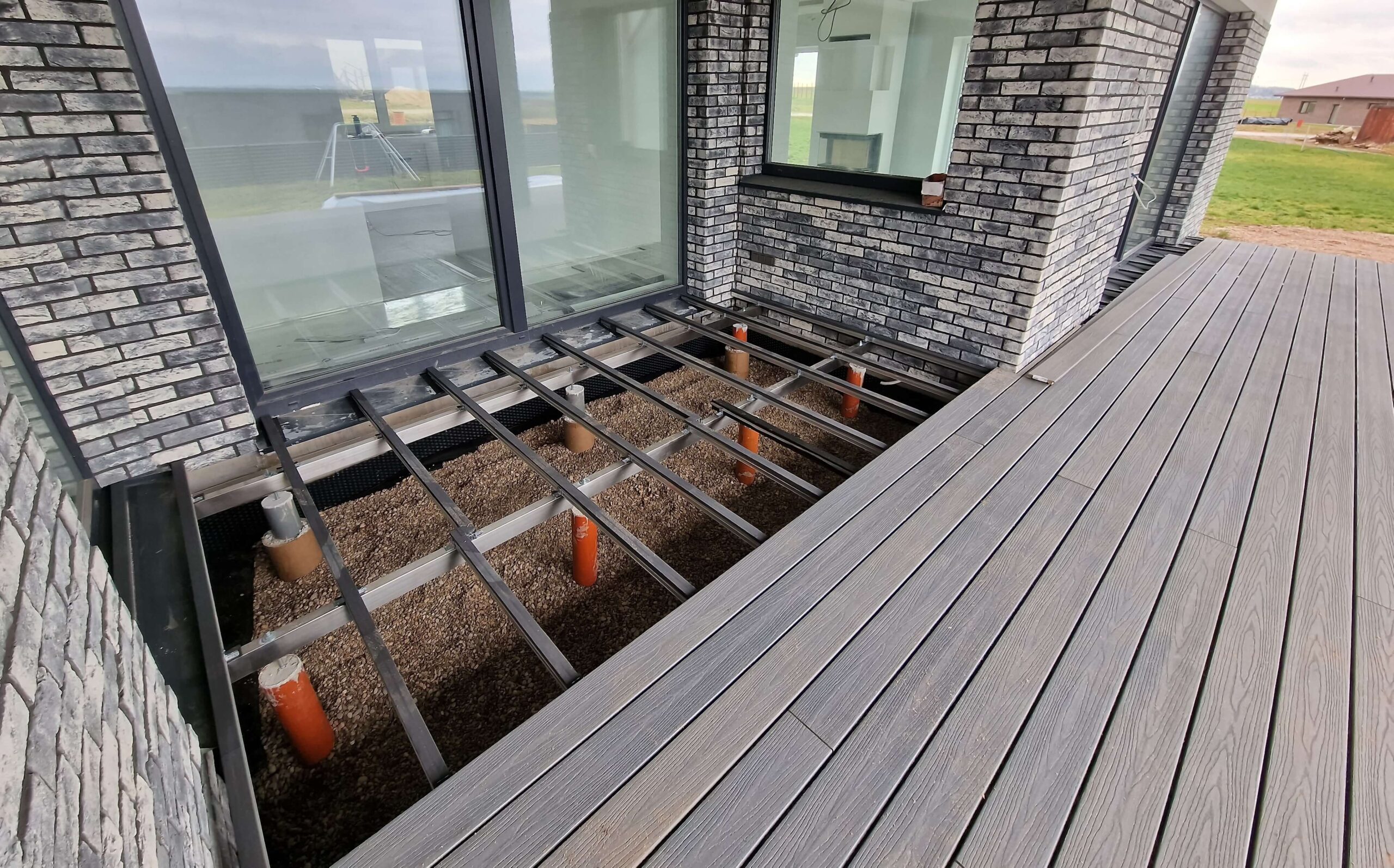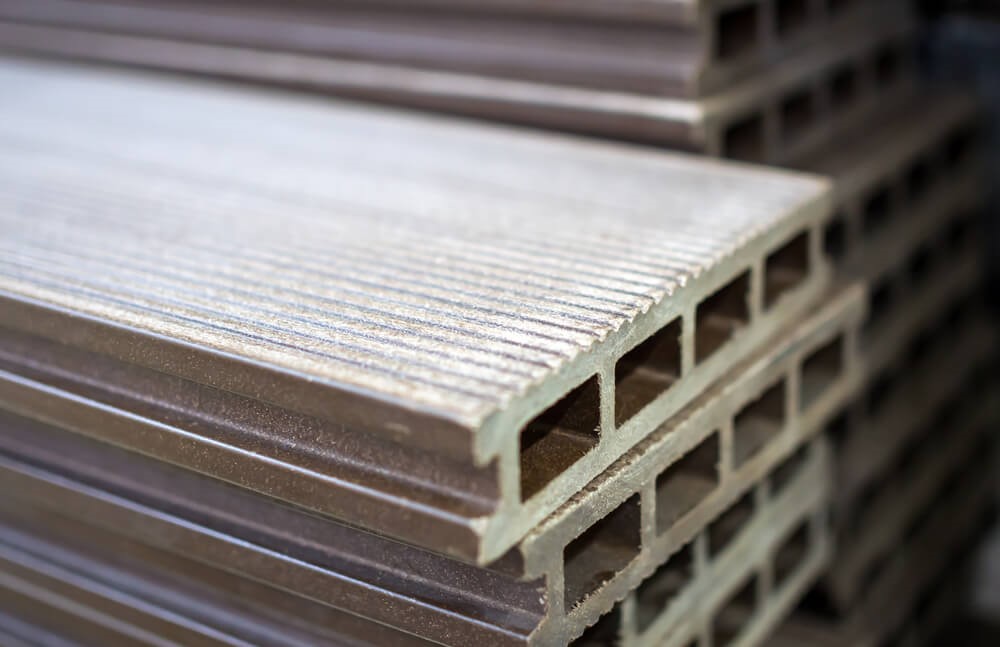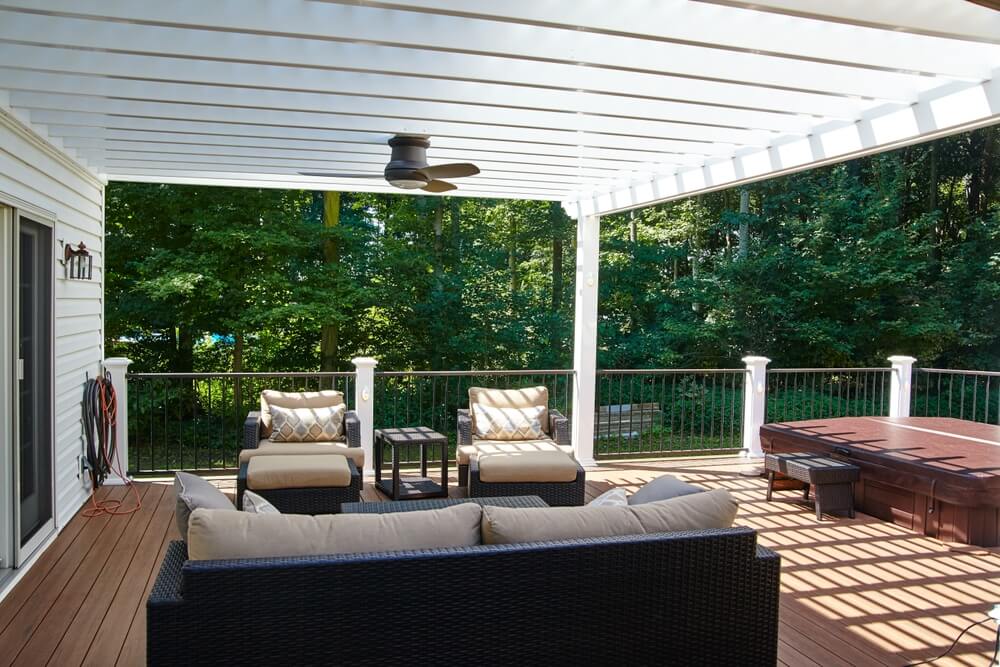Selecting the right decking material for your outdoor space can be a daunting task, especially when faced with the choice between composite decking vs timber because both materials have their unique advantages and disadvantages.
Read on for a detailed comparison that will help you make the best decision for your outdoor space.
Key Takeaways
- Composite decking provides superior resistance to elements, wear and tear, and offers longer warranties than timber.
- Composite requires less maintenance with only warm soapy water for cleaning while timber needs annual treatment with oil or stain.
Consider personal preferences and lifestyle needs when selecting decking materials as well as budget for both short-term & long-term costs of composite & timber.
Decking materials
Composite and timber decking are popular choices, but they differ in composition, visual appeal, and upfront costs. Let’s get into the pros and cons of each material.
Composition and manufacturing
Composite decking, also known as composite boards, is made from a combination of wood fibres and recycled plastics, offering a durable alternative to natural timber decking. The materials are mixed with bonding agents and various coloured tints to create a weather-resistant product suitable for all climates.
In contrast, timber decking is made from hardwood, and its performance depends on factors like climate conditions, geographical location, and purpose of use.
The different compositions of composite and timber decking impact their resistance to weather and moisture. Composite decking is fully capped, which means it provides superior protection against moisture damage, while timber decking is more vulnerable to such elements.
When choosing between composite and timber decking, the compositions and manufacturing processes of each decking are definitely something to consider.
Aesthetics
When it comes to visual appeal, timber decking offers a more natural look, while composite decking offers a wider range of design options.
WoodEvo composite decking boards, for example, feature a wider range of textured finishes and colours that closely resemble natural wood like oak, teak, tallowwood and more. Not to mention, these colours don’t fade easily even after years of usage.
Timber decking, on the other hand, requires treatment to maintain its colour and can fade if left untreated.
Upfront costs
Composite decking boards are definitely more expensive than timber. However, while composite decking generally has a higher initial cost than timber decking, the investment can be recouped within 2-3 years if you consider the maintenance costs.
Timber decking requires annual treatment with oils or stains, and the labour involved can add up over time, making it more expensive in the long run.
If costs are a deciding factor when deciding between composite and timber decking materials, both the initial and long-term expenses should be factored in. In this case, we have a clear winner.
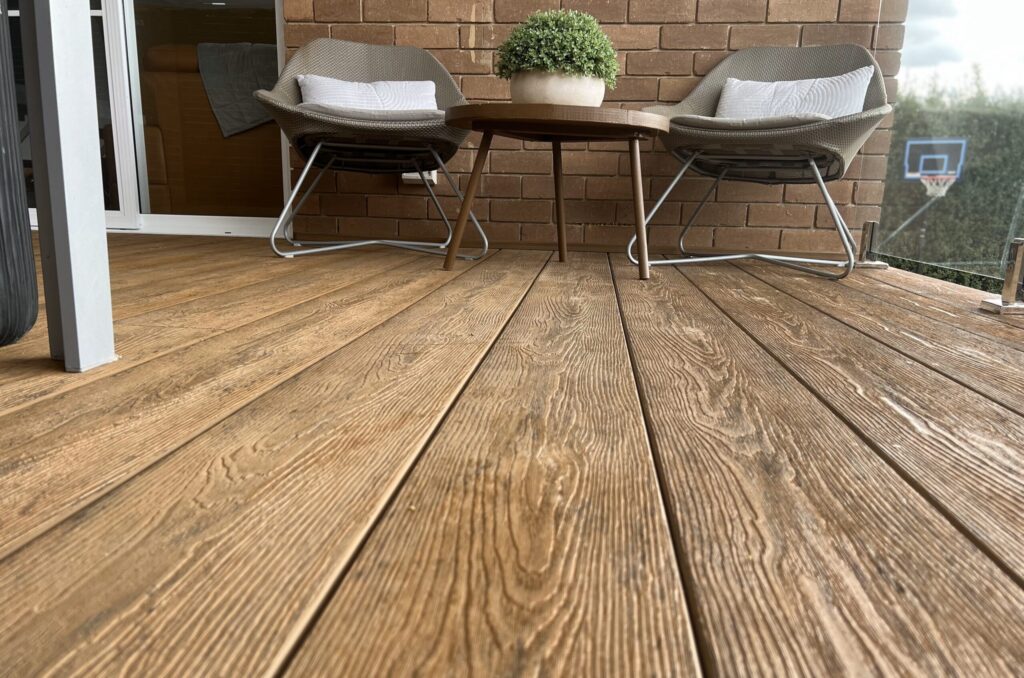
Durability
The longevity and durability of your outdoor space are crucial factors when comparing decking materials.
Composite decking is known for its resistance to moisture, mould, and mildew, as well as its ability to withstand wear and tear without warping, splitting, or cracking. Timber decking, in contrast, is more susceptible to these issues over time.
Here’s how the two compare to each other.
Resistance to elements
When it comes to enduring various weather conditions, composite decking definitely takes the lead over timber decking. Its weather-resistant characteristics make it a suitable choice for any climate, while timber decking is more susceptible to changes in moisture and temperature.
Materials used in composite decking, such as high-density polyethylene and wood fibres, contribute to its superior resistance, making it an all-weather-friendly choice.
Wear and Tear
Composite decking offers several advantages over timber decking:
- It is less prone to wear and tear, such as cracking, splintering, and warping.
- The use of wood-plastic composite materials increases its durability and ensures a longer lifespan for your outdoor space.
- It is not attractive to termites and is resistant to mould, further enhancing its longevity.
In terms of wear and tear, composite decking proves to be the more resilient choice.
Warranty considerations
Composite decking often comes with longer warranties than timber decking, providing extra peace of mind regarding your investment.
WoodEvo composite decking boards are no stranger to decades-long warranties. Our Home and Home Plus ranges offer up to 25 years of warranty while our top of the line WoodEvo Home Advanced range guarantees up to 30 years.
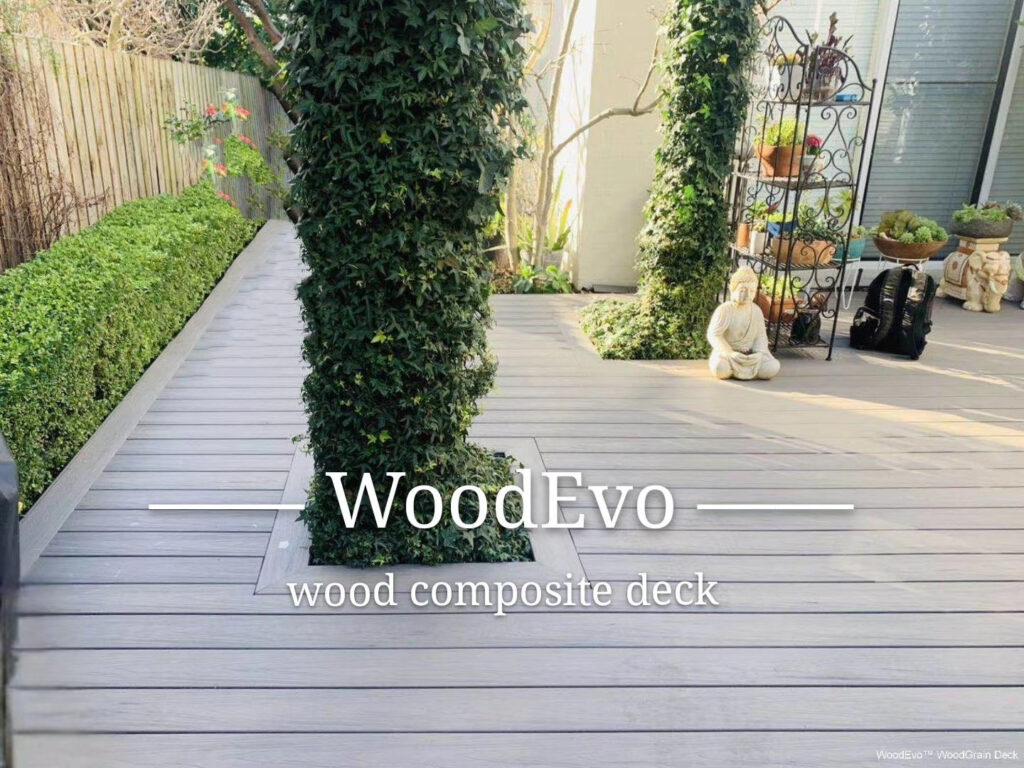

Decking maintenance
When deciding on decking materials, maintenance also plays a big factor.
Composite decking is a low-maintenance option compared to timber decking, which requires regular painting, staining, and sealing for protection and longevity.
In terms of composite decking maintenance, warm soapy water and a soft brush are enough for most cleaning tasks. In contrast, timber decking requires more care, including annual treatment with oil or stain, and sanding down splinters.
This makes composite decking come out on top in terms of long-term upkeep costs due to its durability and low-maintenance properties. While timber decking may be cheaper initially, the ongoing maintenance and labour costs can make it more costly in the long run.
Sustainability and environmental impact
Both composite and timber decking materials have unique sustainability and environmental impact considerations. Composite decking is more eco-friendly due to its use of recycled materials and reduced maintenance requirements, while timber decking is a renewable resource and biodegradable.
A detailed comparison of these materials, focusing on their eco-friendly credentials and harvesting and production methods, is due.
Eco-Friendly Credentials
Composite decking is considered more eco-friendly than timber decking for the following reasons:
- It uses recycled materials, with most composite decking constructed from 95% or more recycled materials.
- It lessens the strain on forests by reducing the need for timber.
- It decreases waste in landfills by utilising recycled materials.
Additionally, the low-maintenance nature of composite decking contributes to its eco-friendliness, as it requires fewer treatments and resources throughout its lifespan.
Harvesting and Production
Timber decking requires the harvesting of trees, while composite decking production uses waste timber and recycled plastics, including timber boards. Sustainable sourcing of timber can reduce its environmental impact, and products purchased from local or regional companies generate fewer carbon emissions than those shipped from distant locations.
In contrast, not all composite materials are created equal; composite decking, for instance, is made from a combination of recycled wood fibre and plastics, reducing its ecological footprint and promoting a more sustainable future.
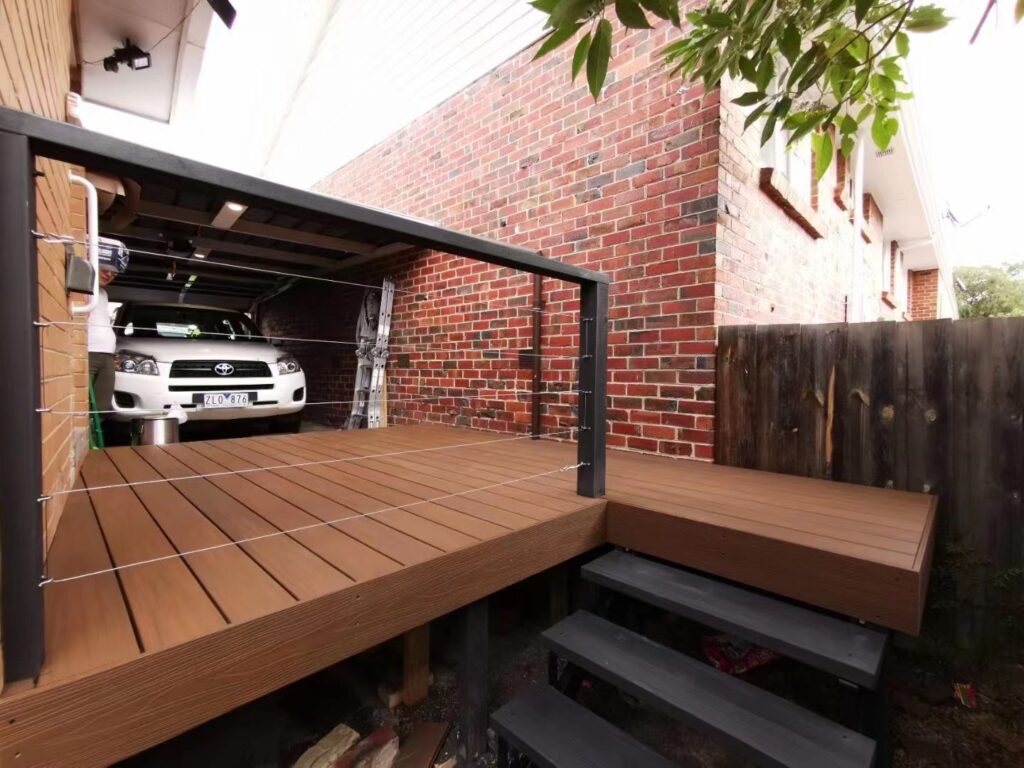

Safety and comfort
When it comes to safety and comfort underfoot, composite and timber decking offer unique benefits. Composite decking provides a splinter-free surface, making it safer for barefoot walking, while timber decking has natural insulation properties that help it stay cooler under the sun.
The specifics of splinter-free surfaces and heat absorption and reflection properties of these decking materials warrant further discussion.
Splinter-Free Surfaces
Composite decking offers a significant advantage in terms of safety and comfort underfoot, as it provides a splinter-free surface. Its composition of plastic and wood fibers ensures a seamless and secure surface for walking barefoot, free from the risk of painful splinters associated with timber decking.
This feature makes composite decking a safer and more comfortable option for outdoor spaces frequented by children and barefoot walkers.
Heat Absorption and Reflection
Composite and timber decking absorb and reflect heat differently, affecting the surface temperature underfoot. However, modern technologies mean that high quality composite decking won’t necessarily absorb any more heat than traditional timber.
Understanding the heat absorption and reflection properties of these decking materials can help you make a more informed decision for your outdoor space. And that’s something that you can discuss with our composite decking specialists here at WoodEvo.
Style and customisation
The style and customisation options of composite and timber decking materials play a significant role in creating the perfect outdoor space. Composite decking offers a variety of colour and finishing options, while timber decking requires staining or painting to maintain its appearance.
The following sections will discuss in detail colourfastness, finishing options, and the ability of both materials to mimic the look of wood.
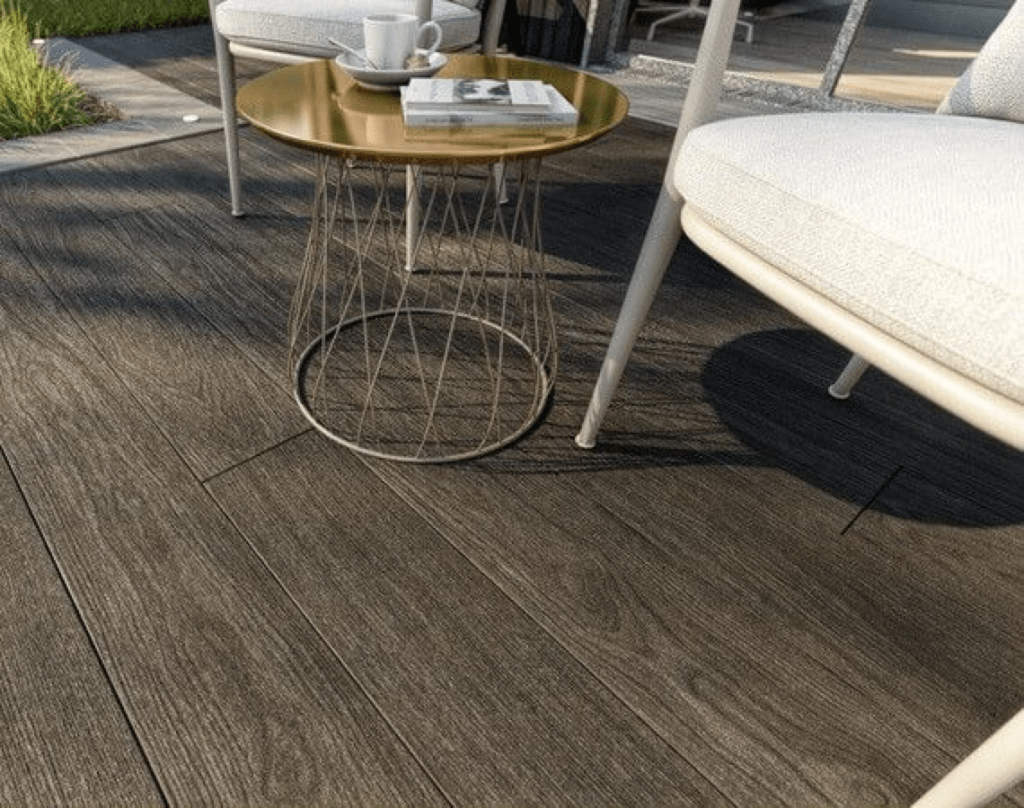

Colorfastness and Finishing Options
WoodEvo offers a wide range of colours, including:
- Teak
- Charcoal
- Basalt
- Tallowwood
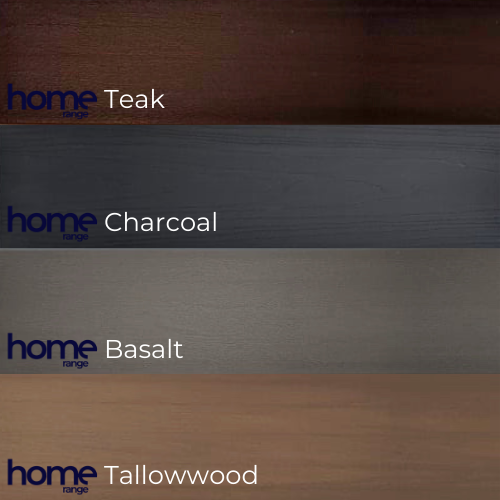

- Barossa
- Nordic
- Hampton
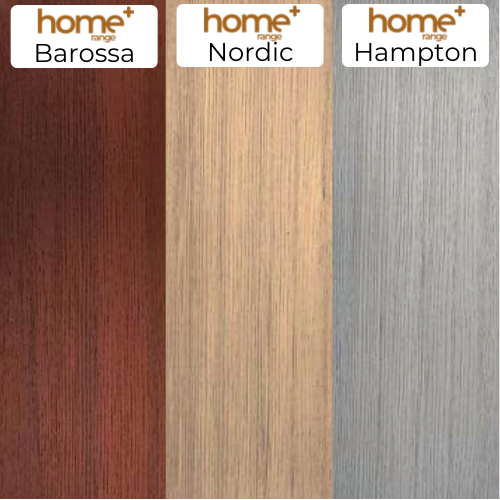

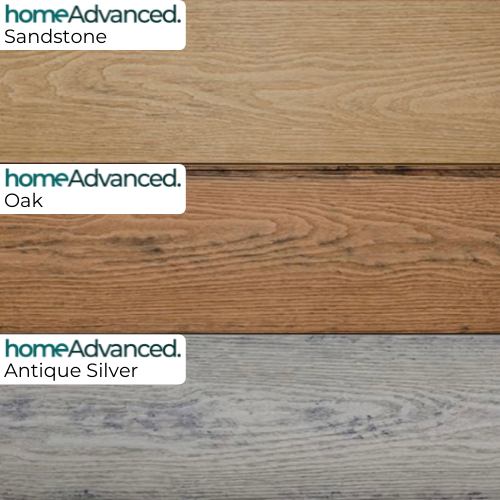

In contrast, timber decking requires staining or painting to maintain its appearance and protect against the elements. Colorfastness and finishing options should be taken into account when selecting the decking material that aligns with your taste.
Mimicking the Look of Wood
Composite decking can closely mimic the look of wood, offering a similar aesthetic to timber decking. Many composite decking options are designed to emulate the aesthetic of real wood, with textures, grain patterns, and colour variations that closely resemble natural wood.
As composite technology advances and higher-quality composite materials are developed, the gap between composite decking and real wood in terms of appearance is diminishing, offering a natural look that is just as captivating.
Making the Right Choice for Your Outdoor Space
To make the right choice for your outdoor space, consider your personal preferences, lifestyle needs, and budgeting for both initial and long-term costs. Composite and timber decking have unique advantages and disadvantages, and the best choice will depend on factors such as aesthetics, maintenance, durability, and environmental impact.
The following sections are dedicated to guiding you in evaluating your preferences and need to make an informed choice for your ideal outdoor oasis.
Personal Preferences and Lifestyle Needs
Personal preferences and lifestyle needs play a significant role in the selection of decking materials. Some may prefer the natural appearance and feel of timber decking, while others may favour the minimal upkeep and longevity of composite decking. Aesthetics, texture, colour options, and environmental friendliness can also affect personal preferences.
Ultimately, the decision is dependent on the individual’s lifestyle, budget, and priorities.
Budgeting for Now and Later
An assessment of both the initial and long-term costs of composite and timber decking is important for a well-informed decision regarding your outdoor space. While composite decking typically has a higher initial cost, it can be recouped within 2-3 years when accounting for maintenance costs.
In contrast, timber decking may have a lower initial cost but may require more upkeep and labor costs over time. Carefully considering the costs associated with each decking material will help you make the best choice for your outdoor space.
Summary
In conclusion, both composite and timber decking materials offer unique advantages and disadvantages. Composite decking is more durable, low-maintenance, and environmentally friendly, while timber decking provides a natural look with a comforting and sturdy aesthetic.
When choosing between these materials, consider factors such as your personal preferences, lifestyle needs, initial and long-term costs, and environmental impact. By carefully weighing these factors, you’ll be well-equipped to make the right choice for your perfect outdoor space.
If you’re in Australia looking for composite decking, you should talk to us here at WoodEvo. We’re the creators of a range of composite wood products including composite decking and composite cladding. Get to know the WoodEvo difference today.
